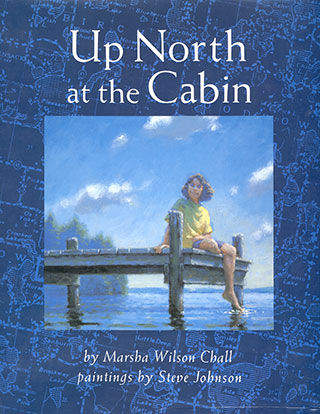Learning Strategies for Up North at the Cabin
Thanks to educator Lowell Eberwein:
Up North at the Cabin is written in a style that is almost poetic. It is meant to be read aloud and creates many visual images, especially if you have been to Lake Mille Lacs, Live Deer Park, and other lake settings in Northern Minnesota. Although some may not agree with this extension, it is almost patterned language. Notice how many times “Up north at the cabin” is repeated throughout the book.
This is too good of a chance to miss with intermediate grade level children. Children should take the syntax of this title and create their own book utilizing Marsha’s poetic patterns. Marsha is a poetic artist who weaves words together to create visual images. Steve Johnson, a Minnesota resident, has visited these places, too. The fusion of these two “artists” makes one think that going Up North at the Cabin is Valhalla and has no mosquitoes.
The learning strategy that would be useful with this book is to have students study Marsha’s writing style and model a narrative plus a picture to fit the narrative. In some ways, this is a structured Language Experience Activity. The end product would be a picture plus a poetic verse using a free style of writing.
I would first have the children do a slot-and-filler analysis of the title.
Up
adverb
North
place noun
at
preposition
the
article
Cabin
place noun
Although I would use adverb, noun, preposition, and adjective, I would not ask children at this level to have this level of grammatical sophistication. What I would ask them to do is to fit words into slots to make new titles. For example:
Down
South
at
the
Beach
Downstairs
in
our
Basement
Downtown
at
the
Movie
Across
the field
to
the
Prairie
From this title, students would describe the place using a free poetic verse style. Then using a medium of choice, the students would illustrate their writing.
One of the secrets to make this work would be to re-read Up North at the Cabin many times. One surface reading gets only at the visual images created by the pictures and narrative. To get to a deeper level, one must hear these verses numerous times.
I would also ask the students to choose two favorite pages from the story and copy each narrative. Somehow, I find I learn much more about the author’s style when I copy the text. It seems copying gets one closer to what is going on in the author’s head when she/he writes. In some ways, “one becomes the author.”
I envision this as a week-long project. I would read the story in either the fall or spring. I would begin this mini-unit by reading the story on a Friday afternoon. The following Monday, I would re-read the story again. This time I would ask the students to form visual images of what they are thinking about as they hear the words. If appropriate, I would give them paper and crayons, and ask them to draw a picture.
Tuesday, I would play the slotting game with Up North at the Cabin (as shown above). I would then put the students into groups of two and have each student to come up with a title that each person is interested in developing. The purpose of the paired grouping is to bounce a title off another person to see if it has value.
Wednesday, Thursday, and Friday will be spent on development of the narrative and the picture. This timing may need to go to mid-week in the second week. The last day will be spent on sharing their writing and picture. If possible, I would like to share this with the other students at my grade level in an audience situation. If the new stories and pictures turn out to be of good quality, I would ask the students to write invitations to their parents and invite them also (another place to practice writing skills).
Up North at the Cabin is a delightful story and modeling this style of writing would broaden the students’ writing repertoire, which is the purpose of this activity.
North Woods Activity
Storyteller, campfire builder, I am the fire, star watcher
Five Senses Word
What do you see? hear? smell? touch? taste?
Suggest metaphor here; e.g., what else does wind sound like?
Vital Verbs
Words that describe actions we can make with our necks, heads, waists, hands, fingers, feet
Place
Features of room or building: ceiling, corner, window, floor, lights

